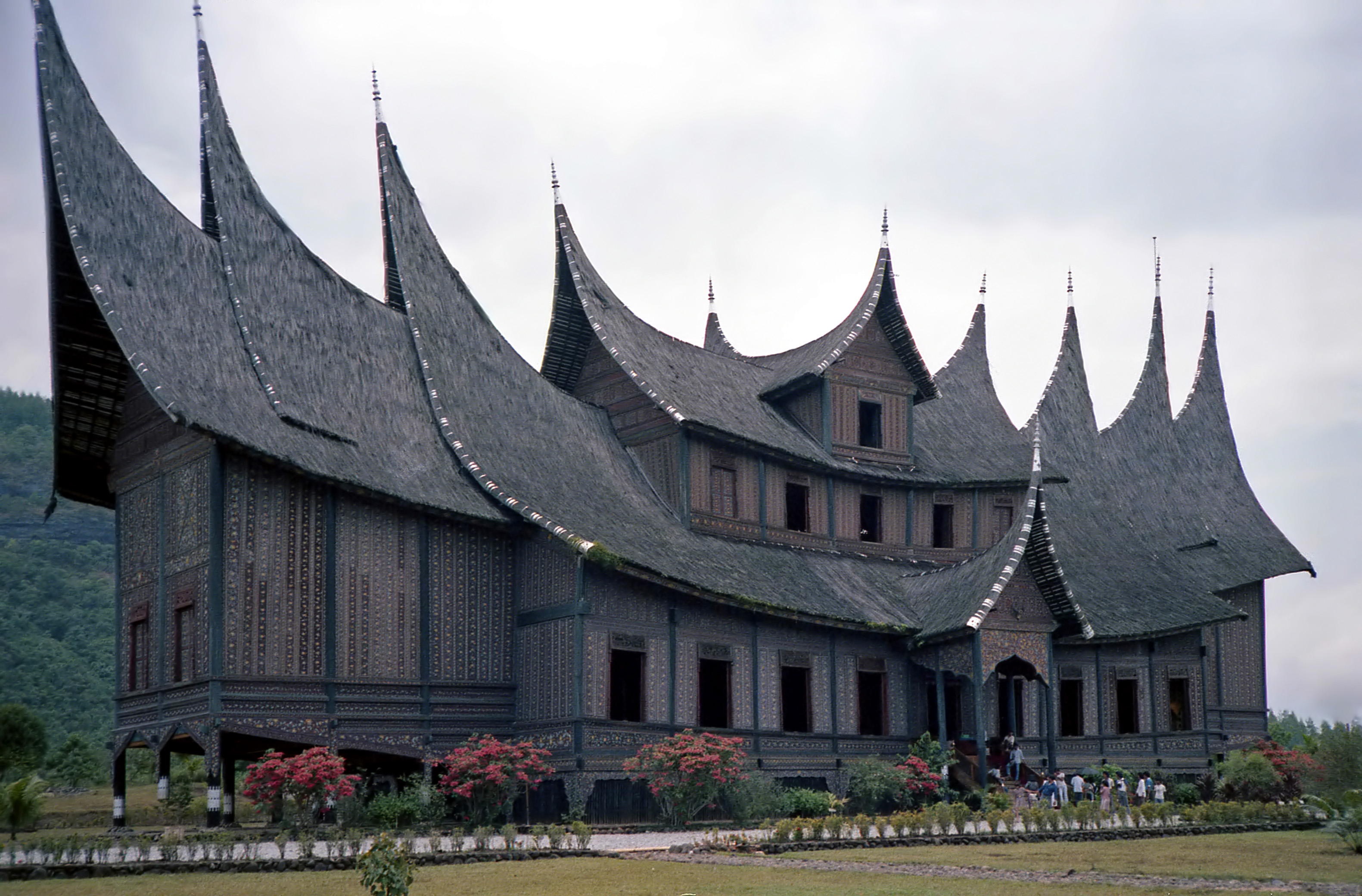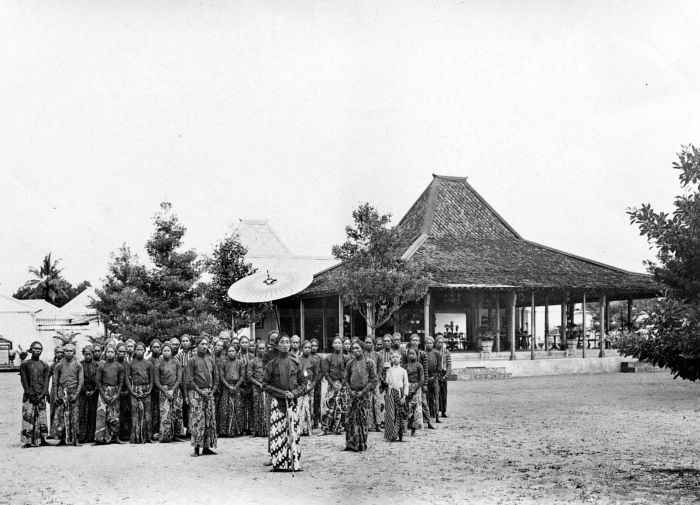|
Pendopo
A pendhapa or pandhapa ( Javanese: ꦥꦼꦤ꧀ꦝꦥ or ꦥꦤ꧀ꦝꦥ, Indonesian spelling: pendapa, nonstandard spelling: pendopo) is a fundamental element of Javanese architecture unique in the southern central part of Java; a large pavilion-like structure built on columns. Either square or rectangular in plan, it is open on all sides and provides shelter from the sun and rain, but allows breeze and indirect light. The word ''pendhapa'' is cognate to the Sanskrit word ''mandapa'' ("hall"). The Dutch writer Multatuli in his colonial reformist novel ''Max Havelaar'' described the pendhapa thus: "After a broad-brimmed hat, an umbrella, or a hollow tree, a 'pendoppo' icis certainly the most simple representation of the idea 'roof'." Derived from ancient Javanese architectural elements, pendhapa are common ritual spaces primarily intended for ceremony, and also for a purposes such as receiving guests in the compounds of wealthy Javanese, and even as cottage industry work spaces ... [...More Info...] [...Related Items...] OR: [Wikipedia] [Google] [Baidu] |
Ratu Boko
Ratu Boko ( jv, Ratu Baka) or Ratu Boko Palace is an archaeological site in Java. Ratu Boko is located on a plateau, about three kilometres south of Prambanan temple complex in Yogyakarta, Indonesia. The original name of this site is still unclear, however the local inhabitants named this site after King Boko, the legendary king mentioned in Roro Jonggrang folklore. In Javanese language, Javanese, ''Ratu Boko'' means "Stork King". The site covers 16 hectares in two hamlets (''Dawung'' and ''Sambireja'') of the village of Bokoharjo and Prambanan, Sleman Regency. In striking contrast to other Classic-period sites in Central Java and Yogyakarta, which are remains of temples, Ratu Boko displays attributes of an occupation or Human settlement, settlement site, although its precise function is unknown. Probably the site was a palace complex which belonged to the kings of Sailendra or Mataram Kingdom that also built temples scattered across the Prambanan Plain. The argument was based on ... [...More Info...] [...Related Items...] OR: [Wikipedia] [Google] [Baidu] |
Indonesian Architecture
The architecture of Indonesia reflects the diversity of cultural, historical and geographic influences that have shaped Indonesia as a whole. Invaders, colonizers, missionaries, merchants and traders brought cultural changes that had a profound effect on building styles and techniques. Numbers of Indonesian vernacular houses have been developed throughout the archipelago. The traditional houses and settlements of the several hundreds ethnic groups of Indonesia are extremely varied and all have their own specific history. The houses hold social significance in society and demonstrate local ingenuity in their relations to environment and spatial organisation. Traditionally, the most significant foreign influence has been Indian. However, Chinese, Arab, and European influences have also played significant roles in shaping Indonesian architecture. Religious architecture varies from indigenous forms to mosques, temples, and churches. The sultans and other rulers built palaces. The ... [...More Info...] [...Related Items...] OR: [Wikipedia] [Google] [Baidu] |
Joglo
Joglo is a type of traditional vernacular house of the Javanese people (Javanese ''omah''). The word ''joglo'' refers to the shape of the roof. In the highly hierarchical Javanese culture, the type of the roof of a house reflects the social and economic status of the owners of the house; joglo houses is traditionally associated with Javanese aristocrats. Joglo roof can be implemented to a dwelling (''omah'') or a pavilion (''pendopo''). Structure and architecture The joglo roof is the most complex of all Javanese roof types. Different with the other type of Javanese roof such as the limasan and kampung roof, joglo roof does not use king posts. Joglo roof consists of columns that become higher as it go to the center. The four innermost main house columns are often the tallest, while the outer columns are the lowest. These four innermost house columns support a roof that is the steepest of all type of Javanese roof; almost forming a pyramid, except that it comes to two point ... [...More Info...] [...Related Items...] OR: [Wikipedia] [Google] [Baidu] |
Majapahit
Majapahit ( jv, ꦩꦗꦥꦲꦶꦠ꧀; ), also known as Wilwatikta ( jv, ꦮꦶꦭ꧀ꦮꦠꦶꦏ꧀ꦠ; ), was a Javanese people, Javanese Hinduism, Hindu-Buddhism, Buddhist thalassocracy, thalassocratic empire in Southeast Asia that was based on the island of Java (in modern-day Indonesia). It existed from 1293 to circa 1527 and reached its peak of glory during the era of Hayam Wuruk, whose reign from 1350 to 1389 was marked by conquests that extended throughout Southeast Asia. His achievement is also credited to his prime minister, Gajah Mada. According to the () written in 1365, Majapahit was an empire of 98 tributaries, stretching from Sumatra to New Guinea; consisting of present-day Indonesia, Singapore, Malaysia, Brunei, southern Thailand, Timor Leste, southwestern Philippines (in particular the Sulu Archipelago) although the scope of Majapahit sphere of influence is still the subject of debate among historians. The nature of Majapahit relations and influences upon its ... [...More Info...] [...Related Items...] OR: [Wikipedia] [Google] [Baidu] |
Mandapa
A mandapa or mantapa () is a pillared hall or pavilion for public rituals in Indian architecture, especially featured in Hindu temple architecture. Mandapas are described as "open" or "closed" depending on whether they have walls. In temples, one or more mandapas very often lie between the sanctuary and the temple entrance, on the same axis. In a large temple other mandapas may be placed to the sides, or detached within the temple compound. Temple architecture In the Hindu temple the ''mandapa'' is a porch-like structure through the (''gopuram'') (ornate gateway) and leading to the temple. It is used for religious dancing and music and is part of the basic temple compound. The prayer hall was generally built in front of the temple's ''sanctum sanctorum'' (''garbhagriha''). A large temple would have many ''mandapa''. If a temple has more than one ''mandapa'', each one is allocated for a different function and given a name to reflect its use. For example, a ''mandapa'' ... [...More Info...] [...Related Items...] OR: [Wikipedia] [Google] [Baidu] |
Javanese Culture
Javanese culture is the culture of the Javanese people. Javanese culture is centered in the provinces of Central Java, Yogyakarta and East Java in Indonesia. Due to various migrations, it can also be found in other parts of the world, such as Suriname (where 15% of the population are of Javanese descent), the broader Indonesian archipelago region, Cape Malay, Malaysia, Singapore, Netherlands and other countries. The migrants bring with them various aspects of Javanese cultures such as music, traditional dances and art of shadow play. The migration of Javanese people westward has created the coastal Javanese culture that is distinct from inland Sundanese culture in West Java and Banten. Being the largest ethnic group, the Javanese culture and people influence Indonesian politics and culture, a process sometimes described as Javanisation. Literature Javanese literature tradition is among the earliest and the oldest surviving literature traditions in Indonesia. The transla ... [...More Info...] [...Related Items...] OR: [Wikipedia] [Google] [Baidu] |
Javanese Traditional House
Javanese traditional house ( jv, ꦲꦺꦴꦩꦃꦠꦿꦝꦶꦱꦶꦪꦺꦴꦤꦭ꧀ꦗꦮ, Omah tradhisional Jawa) refers to the traditional vernacular houses of Javanese people in the island of Java, Indonesia. See also * Indonesian architecture * Rumah adat * Kraton (Indonesia) * List of mosques in Indonesia * Dutch Indies country houses * Kotagede Kotagede (Javanese: ꦏꦸꦛꦒꦼꦝꦺ ''Kuthagedhé'') is a city district (''kemantren'') and a historic neighborhood in Yogyakarta, Special Region of Yogyakarta, Indonesia. Kotagede contains the remains of the first capital of Mataram Sultana ... References Works cited * * * {{Indonesian architecture Rumah adat Javanese culture House types ... [...More Info...] [...Related Items...] OR: [Wikipedia] [Google] [Baidu] |
Floor Plan
In architecture and building engineering, a floor plan is a technical drawing to scale, showing a view from above, of the relationships between rooms, spaces, traffic patterns, and other physical features at one level of a structure. Dimensions are usually drawn between the walls to specify room sizes and wall lengths. Floor plans may also include details of fixtures like sinks, water heaters, furnaces, etc. Floor plans may include notes for construction to specify finishes, construction methods, or symbols for electrical items. It is also called a ''plan'' which is a measured plane typically projected at the floor height of , as opposed to an ''elevation'' which is a measured plane projected from the side of a building, along its height, or a section or ''cross section'' where a building is cut along an axis to reveal the interior structure. Overview Similar to a map, the orientation of the view is downward from above, but unlike a conventional map, a plan is drawn at a part ... [...More Info...] [...Related Items...] OR: [Wikipedia] [Google] [Baidu] |
Architecture
Architecture is the art and technique of designing and building, as distinguished from the skills associated with construction. It is both the process and the product of sketching, conceiving, planning, designing, and constructing buildings or other structures. The term comes ; ; . Architectural works, in the material form of buildings, are often perceived as cultural symbols and as works of art. Historical civilizations are often identified with their surviving architectural achievements. The practice, which began in the prehistoric era, has been used as a way of expressing culture for civilizations on all seven continents. For this reason, architecture is considered to be a form of art. Texts on architecture have been written since ancient times. The earliest surviving text on architectural theories is the 1st century AD treatise '' De architectura'' by the Roman architect Vitruvius, according to whom a good building embodies , and (durability, utility, and beauty). ... [...More Info...] [...Related Items...] OR: [Wikipedia] [Google] [Baidu] |
Javanese Language
Javanese (, , ; , Aksara Jawa: , Pegon: , IPA: ) is a Malayo-Polynesian language spoken by the Javanese people from the central and eastern parts of the island of Java, Indonesia. There are also pockets of Javanese speakers on the northern coast of western Java. It is the native language of more than 98 million people. Javanese is the largest of the Austronesian languages in number of native speakers. It has several regional dialects and a number of clearly distinct status styles. Its closest relatives are the neighboring languages such as Sundanese, Madurese, and Balinese. Most speakers of Javanese also speak Indonesian for official and commercial purposes as well as a means to communicate with non-Javanese-speaking Indonesians. There are speakers of Javanese in Malaysia (concentrated in the West Coast part of the states of Selangor and Johor) and Singapore. Javanese is also spoken by traditional immigrant communities of Javanese descent in Suriname, Sri Lanka an ... [...More Info...] [...Related Items...] OR: [Wikipedia] [Google] [Baidu] |
Kejawèn
''Kejawèn'' ( jv, ꦏꦗꦮꦺꦤ꧀, Kajawèn) or Javanism, also called Kebatinan, ''Agama Jawa'', and '' Kepercayaan'', is a Javanese religious tradition, consisting of an amalgam of animistic, Buddhist, and Hindu aspects. It is rooted in Javanese history and religiosity, syncretizing aspects of different religions. Definitions The term ''kebatinan'' is being used interchangeably with ''kejawèn'', ''Agama Jawa'' and '' Kepercayaan'', although they are not exactly the same: * Kebatinan: "the science of the inner", "inwardness", derived from the Arabic word ''batin'', meaning "inner" or "hidden". * Kejawèn: "Javanism", the culture and religious beliefs and practices of the Javanese people of Central Java and East Java. It is "not a religious category, but refers to an ethic and a style of life that is inspired by Javanist thinking". * Agama Jawa: "the Javanese religion" * Kepercayaan: "belief", "faith", full term: ''Kepercayaan kepada Tuhan Yang Maha Esa'', "Believer in ... [...More Info...] [...Related Items...] OR: [Wikipedia] [Google] [Baidu] |
Java
Java (; id, Jawa, ; jv, ꦗꦮ; su, ) is one of the Greater Sunda Islands in Indonesia. It is bordered by the Indian Ocean to the south and the Java Sea to the north. With a population of 151.6 million people, Java is the world's List of islands by population, most populous island, home to approximately 56% of the Demographics of Indonesia, Indonesian population. Indonesia's capital city, Jakarta, is on Java's northwestern coast. Many of the best known events in Indonesian history took place on Java. It was the centre of powerful Hindu-Buddhist empires, the Islamic sultanates, and the core of the colonial Dutch East Indies. Java was also the center of the History of Indonesia, Indonesian struggle for independence during the 1930s and 1940s. Java dominates Indonesia politically, economically and culturally. Four of Indonesia's eight UNESCO world heritage sites are located in Java: Ujung Kulon National Park, Borobudur Temple, Prambanan Temple, and Sangiran Early Man Site. ... [...More Info...] [...Related Items...] OR: [Wikipedia] [Google] [Baidu] |



.jpg)




